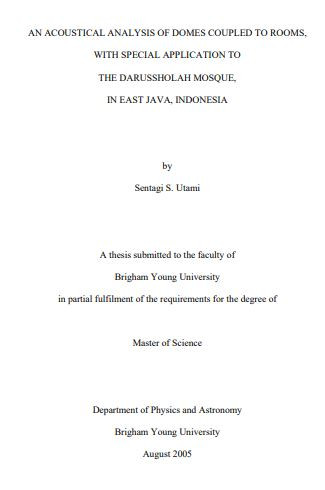
Concave surfaces are often considered to be detrimental or precarious in room acoustics, especially because of the impact they have on the distribution of sound energy. However, it is often difficult to avoid such surfaces in buildings with specific architectural functions. A primary example of this involves mosques, which are sacred places of worship for Muslims. In keeping with the Islamic architectural style, most mosques incorporate a symbolic centralized domed ceiling as part of their roof structures.
These domes are open on the bottom and coupled to the acoustic spaces below. In many cases, the lower spaces may be idealized as rectangular enclosures. Owing to the distinctness and ubiquity of this basic architectural form, a thorough, fundamental analysis of such environments would be useful to the architectural acoustics community. In this study, predictions from EASETM computer models were compared to the results derived from physical scale model measurements. The scale model measurement techniques involved evaluation of impulse responses in a 1:12 scale model of Darussholah mosque, in East Java, Indonesia. A miniature human voice source was created to carry out the impulse response measurements. It was carefully evaluated to ensure that it produced adequate frequency response and directivity comparable to an actual human voice. Acoustical parameters were derived from the impulse responses. Statistical analysis using ANOVA and t-tests were used to compare results from the measurements with variations of domed ceiling configurations and other aspects of the measurement setting. Conclusions were based on these comparisons and on auralization listening tests in order to ascertain the elements that produced the most significant impact on the mosque acoustics. The analysis helps establish criteria for good acoustics in mosques and other buildings with domed ceilings.
Utami, S. S., ‘An Acoustical Analysis of Domes Coupled to Rooms: With Special Application to The Darussholah Mosque, In East Java, Indonesia’ (Unpublished Master Thesis: Brigham Young University, 2009).
I agree to the terms outlined below:
You agree to upload and assign Mosqpedia Database the rights to use the content worldwide and in perpetuity across all current and future media platforms. Mosqpedia Database may edit, copy, adapt and translate your contribution.
The content will be distributed under the Creative Commons Attribution-Deed – Attribution-NonCommercial-NoDerivatives 4.0 International – Creative Commons
All data will be stored in line with data protection regulations.